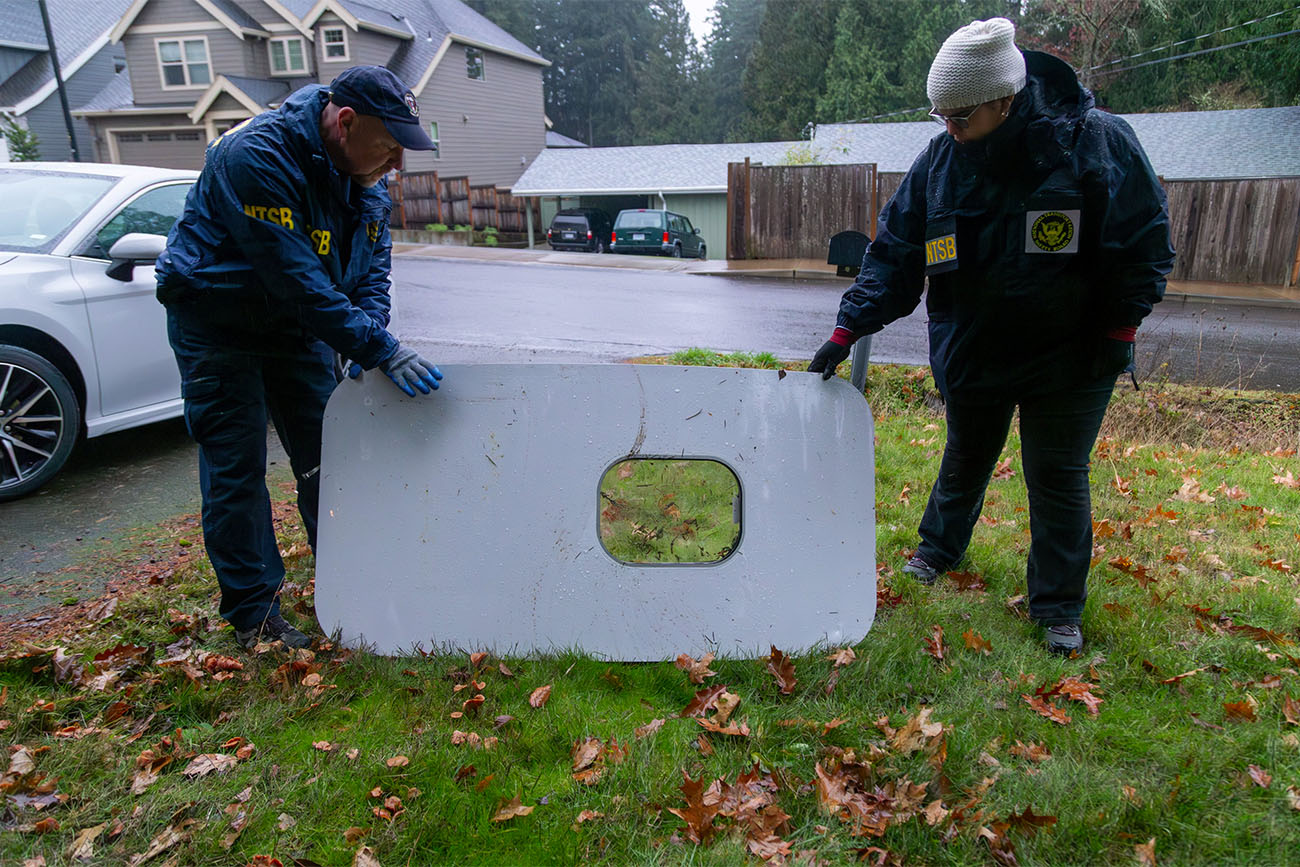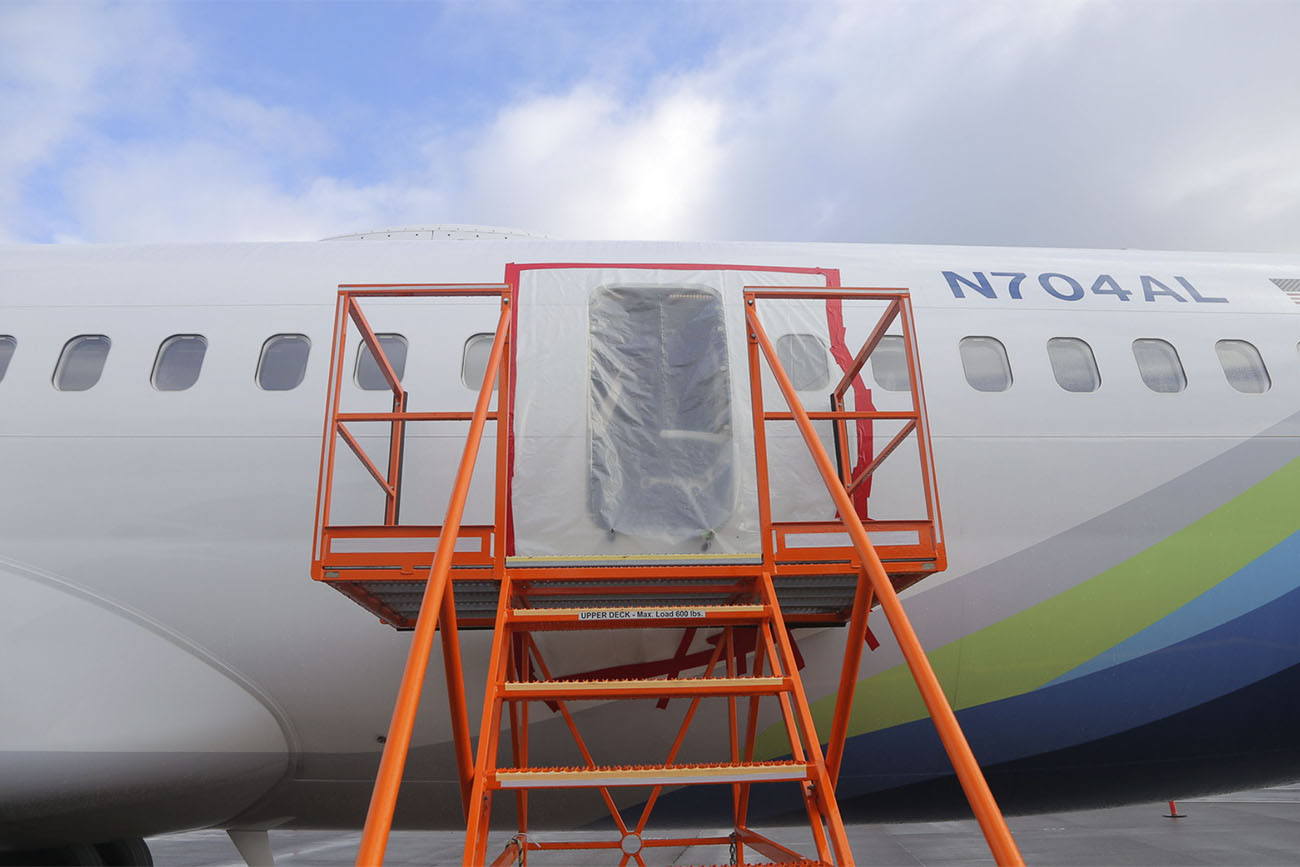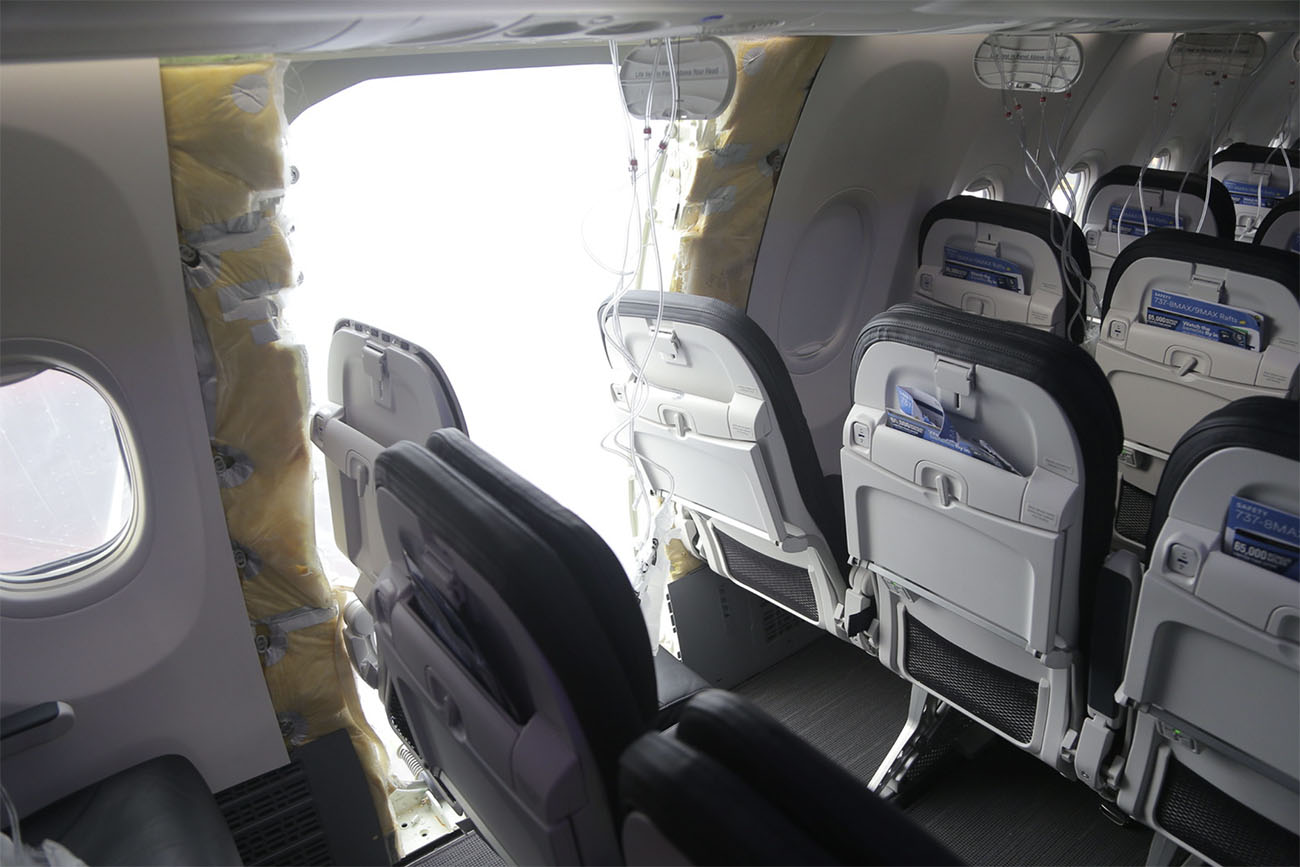First published on 2024/01/09. Last updated on 2024/01/10: “Boeing 737 MAX’s Tarnished Image” section added toward the end of the article.
On January 5, 2024, just a few days after the accident of Japan Airlines flight 516, another accident with a fortunate ending happened on Alaska Airlines flight 1282 when a plug (a component used in place of an unnecessary emergency exit) detached mid-flight.
The accident resulted in the FAA grounding all 737-9s equipped with the same plug and requiring inspections. While the exact cause of the Alaska Airlines accident is still being investigated, plugs with loose bolts were now discovered on some United 737-9s.
Continue reading to learn more.

Alaska Airlines Flight 1282 Loses a Door Plug Mid-Flight
On January 5, 2024, Alaska Airlines’ Boeing 737-9 (a variant of the 737 MAX) registered N704AL took off from Portland Airport bound for Los Angeles as flight AS1282. Just a few minutes after its 5:07 local time take-off, at an altitude of 16,000 feet, the aircraft experienced a decompression as a plug used in place of an emergency exit detached from the aircraft.
The decompression resulted in some of the passengers’ belongings including cell phones being blown out of the aircraft. It also caused the cockpit door to open.
Following the accident, the aircraft turned around and landed back in Portland about 20 minutes after it took off. Fortunately, all 171 passengers and six crew members were able to walk off the aircraft safely with only three minor injuries being reported.


After the accident, a couple of cell phones were reported to be found along the aircraft’s flight path. Incredibly, one iPhone survived the fall from the aircraft intact.
The plug was found by a teacher named Bob in his backyard in Oregon to which, at a press conference about the accident, the National Transportation Safety Board (NTSB) Chair Jennifer Homendy noted “Thank you, Bob.”
While it seems like the NTSB will have data from the flight data recorder available during the investigation, the data from the cockpit voice recorder was lost.
Homendy, who is trying to have the duration of the cockpit voice recorder data expanded from just two hours to 25 hours, expressed her frustration about that “because that information is key, not just for our investigation, but for improving aviation safety.”
Found an iPhone on the side of the road… Still in airplane mode with half a battery and open to a baggage claim for #AlaskaAirlines ASA1282 Survived a 16,000 foot drop perfectly in tact!
When I called it in, Zoe at @NTSB said it was the SECOND phone to be found. No door yet???? pic.twitter.com/CObMikpuFd
— Seanathan Bates (@SeanSafyre) January 7, 2024
Boeing 737-9s with Plugs Grounded Worldwide
Immediately following the accident, Alaska Airlines’ CEO Ben Minicucci issued a statement saying “We have decided to take the precautionary step of temporarily grounding our fleet of 65 Boeing 737-9 aircraft. Each aircraft will be returned to service only after completion of full maintenance and safety inspections.”
The following day, 18 of Alaska’s 737-9s were put back into service due to having “had in-depth and thorough plug door inspections performed as part of a recent heavy maintenance visit.”
However, on January 6, 2024, just a few hours after Alaska’s announcement that it had put some aircraft back into service, all 737-9s with mid-cabin door plugs installed were grounded through an emergency airworthiness directive (EAD) issued by the FAA. On January 7, 2024, the European Union Aviation Safety Agency (EASA) followed the FAA’s lead by adopting its EAD.

As a result of the EAD, the 18 Alaska 737-9s that were returned into service were grounded again. United Airlines, Copa Airlines, and Turkish Airlines grounded their 737-9s equipped with plugs too.
While Icelandair, SCAT, Lion Air, and flydubai operate the 737-9 too, their aircraft are equipped with optional emergency exit doors rather than plugs.
Nonetheless, whether due to actual safety concerns or as a precaution against bad press, Indonesia’s transport ministry temporarily grounded Lion Air’s 737-9s. One of the airline’s 737-8s (another 737 MAX variant) was involved in a deadly accident in 2018.
United Airlines and Alaska Airlines Find Loose Bolts on Other Aircraft
The airframe involved in the accident was reported to have had a warning light indicating a potential problem with pressurization light up three times in the last month. Two of the times the aircraft was on the ground; on January 3, 2024, the warning light lit up in-flight.
As a result of that, the airframe was restricted from flying long, overwater flights (i.e. flights requiring ETOPS).
What is even more concerning, however, are United Airlines’ findings that were first reported by The Air Current. The airline has confirmed that while inspecting its 737-9s, it “found instances that appear to relate to installation issues in the door plug – for example, bolts that needed additional tightening” on five airframes.
According to The Air Current, the affected aircraft were delivered to United between November 2022 and September 2023 and the loose bolts were not exactly the same ones on each airframe.
Following @jonostrower‘s scoop on United finding 737-9s with loose door plug screws, a source sent this image of one of the door plug’s lower hinge bracket with a note that 2 screws are not screwed all the way in. https://t.co/sz1d997PdL pic.twitter.com/d6hgHAEb2u
— Edward Russell (@ByERussell) January 8, 2024
Later on, Alaska Airlines reported finding some anomalies on some of its other 737-9s too. “As our maintenance technicians began preparing our 737-9 MAX fleet for inspections, they accessed the area in question. Initial reports from our technicians indicate some loose hardware was visible on some aircraft. ”
While the investigation is still ongoing and no conclusions have been made, United’s and Alaska’s findings indicate that the accident could have been a result of insufficient quality control and that it could have been “an accident waiting to happen.” The findings will certainly shift the spotlight to Boeing and its partner Spirit AeroSystems in what appears to be another blow to Boeing’s reputation.
Airlines Working to Get the 737-9 Back in the Air
On January 8, 2024, Boeing provided airlines with the details of FAA-approved inspections that will need to be done before their 737-9s can return into service.
With that, according to Alaska Airlines, two more steps need to be done before the 737-9s can fly again. First, the “FAA must approve operators’ inspection processes to ensure compliance (called an Alternate Methods of Compliance, or AMOC).” Second, “Alaska must develop detailed inspection instructions and processes for our maintenance technicians to follow.”
The situation is likely similar at the other affected airlines.
Boeing 737 MAX’s Tarnished Image
On January 9, 2024, Reuters quoted Boeing CEO Dave Calhoun saying to the company’s employees “We’re going to approach this number one acknowledging our mistake.” He also noted the company will work with the regulators to make sure an accident like that “can never happen again.”
In an earlier statement, Boeing said “We are committed to ensuring every Boeing airplane meets design specifications and the highest safety and quality standards.”
Unfortunately, the latest accident combined with other issues surrounding the latest generation of Boeing airliners including but not limited to the 2018 and 2019 Boeing 737 MAX accidents are not inspiring the public’s and some industry insiders’ trust in Boeing.
After the accident, Ryanair’s CEO Michael O’Leary is quoted saying “I think that both Airbus and Boeing, certainly Boeing, need to significantly improve quality control.” He also added “The 737 is fine. But it doesn’t need these kind of short-term reputational issues.”
The President of Emirates, Tim Clark, told Bloomberg that Boeing “had quality-control problems for a long time now, and this is just another manifestation of that” while adding “I think they’re getting their act together now, but this doesn’t help.”
Both of the executives’ statements need to be taken with a grain of salt since they can be used as a negotiation tool when purchasing aircraft from Boeing. However, that does not change their overall sentiment.
With a good portion of the general flying public not distinguishing between the different aircraft variants, airlines unaffected by the accident are notifying customers that they are not flying the 737-9 but the 737-8 (both variants of the 737 MAX) or that while they are flying the 737-9, they are flying it with an emergency exit rather than the plug that is at the core of the accident.
Summary
On January 5, 2024, Alaska Airlines flight 1282 operated by a 737-9 registered N704AL had to turn around after taking off from Portland bound for Los Angeles due to suffering decompression. The decompression was caused by a plug used in place of an optional emergency exit available to airlines operating the 737-9 in higher-density configurations.
While not confirmed to be related to the accident, the airframe was reported to have had a warning light indicating potential pressurization issues go off three times before the accident and to have been restricted from flying long, overwater flights.
As a result of the accident, the FAA grounded all 737-9s with door plugs and mandated inspections to ensure their proper installation. While inspecting its aircraft, United found five airframes with loose door plug bolts and Alaska reported anomalies too.
This story is developing so I will keep this article updated as new information is released.
